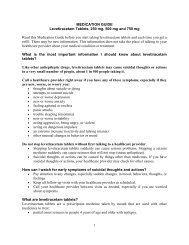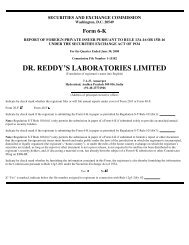DRIVIN G ROWTH - Dr. Reddy's
DRIVIN G ROWTH - Dr. Reddy's
DRIVIN G ROWTH - Dr. Reddy's
Create successful ePaper yourself
Turn your PDF publications into a flip-book with our unique Google optimized e-Paper software.
68<br />
management discussion<br />
and analysis<br />
best equipped to exploit these developments<br />
— such as creating gene based drugs starting<br />
from gene sequencing to analysis and<br />
interpretation to drug development.<br />
Over the last five years, there has been an<br />
attitudinal change among a section of<br />
Indians, who are now spending more on<br />
healthcare. According to the Insurance<br />
Regulatory and Development Authority<br />
(IRDA), the Indian healthcare industry has<br />
the potential to show the same exponential<br />
growth that software has shown in the past<br />
decade. Further, only 10 per cent of the<br />
market potential has been tapped till date —<br />
and market studies indicate the possibility of<br />
achieving 35 per cent growth in the coming<br />
years.<br />
A big opportunity for the industry arises<br />
out of the privatisation of the insurance<br />
segment. There is a vast insurable population<br />
in India — given that only 2 million people,<br />
or 0.2 per cent of the total population, are<br />
covered under Mediclaim. According to a<br />
recent study, there are 315 million<br />
potentially insurable lives in the country. This<br />
should translate into supporting larger<br />
healthcare and pharmaceutical spends.<br />
THREATS<br />
CURRENTLY, ONLY PROCESS patents<br />
are recognised in India. However, by virtue of<br />
India being a member of the World Trade<br />
Organisation (WTO), India has recently passed<br />
legislation to recognise product patents from<br />
2005. This does not affect a discovery-based<br />
company like <strong>Dr</strong>. Reddy’s. However, it will<br />
affect companies that survive only on reverse<br />
engineering. Recognising this fact, some<br />
Indian companies are now stepping up their<br />
research activities to make themselves more<br />
self-sufficient in product development. How<br />
many of them actually develop the R&D<br />
capabilities to contest in the new regime<br />
remains to be seen.<br />
The <strong>Dr</strong>ug Price Control Order (DPCO)<br />
continues to play an active role in the<br />
industry. Sometimes, the pricing authority<br />
arbitrarily sets prices of drugs that fall within<br />
its ambit without giving due consideration<br />
even to the costs of production. This leaves<br />
manufacturers with low margins and, hence,<br />
less funds to invest in world class<br />
manufacturing facilities and R&D activities.<br />
The silver lining is that the span of drug price<br />
control has been substantially reduced in<br />
2001-02. However, since the <strong>Dr</strong>ug Price<br />
Controller is a pure administrative authority<br />
subject to the pressures of government, this<br />
could just as easily be reversed.<br />
All said and done, most Indian<br />
pharmaceutical companies lack the facilities<br />
and resources to develop a molecule, conduct<br />
trials and then launch the product. Indian<br />
companies will thus have to depend on their<br />
international peers to undertake the more<br />
expensive clinical trials and product<br />
launches. Hence, the gains from R&D could<br />
DR. REDDY’S LABORATORIES LTD. | MANAGEMENT DISCUSSION AND ANALYSIS | ANNUAL REPORT 2001-2002




